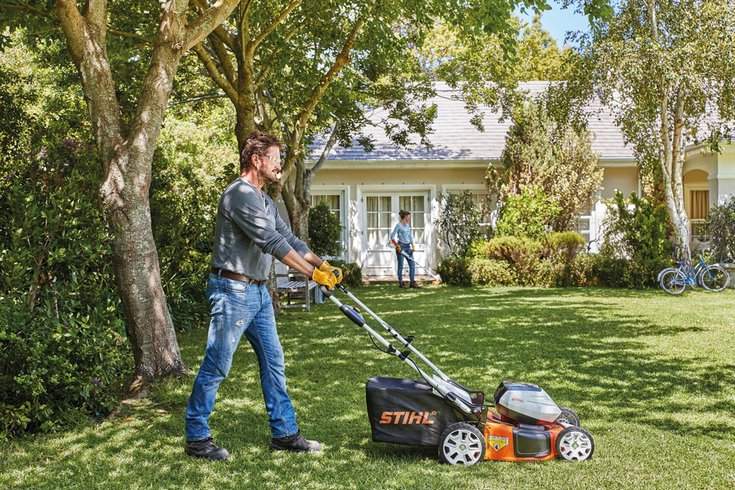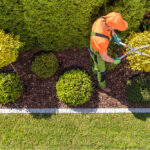The average American spends about 4 hours a week caring for their lawn. Lawn mowing is often the most time-consuming part of routine lawn care. In order to increase lawn care effectiveness, we have created the ultimate guide for how to mow a lawn the right way.
If you are new to mowing, this guide will be the perfect tool to help you learn how to properly mow a lawn. For those who are more experienced, this guide will provide useful advice to perfect the appearance of your lawn.
Wear the Proper Attire
Before learning how to mow a lawn, we will discuss important lawn mowing safety precautions. Based on recent statistics, around 80,000 people are injured by a lawn mower each year. The fast-moving blade can quickly send rocks, and other small objects flying towards you. However, you can avoid these types of injuries by wearing the right attire. Pick clothing that fits snugly and gives you ample flexibility in moving around.
As the summer days peak, you should also think about sun exposure safety. Limiting sun exposure and staying hydrated are essential to having an enjoyable mowing experience.
Here is what we recommend wearing to stay safe:
- Closed Toed Shoes
- Long Pants
- A Pair of Gloves
- Long sleeve shirt
- Goggles or Sunglasses
- Ear Plugs
- Face Mask/Bandana
- Sunhat
Prepare the Lawn
Before getting started, walk around and remove any large objects such as rocks or sticks. This will prevent any damage to the mower blade. Additionally, scan the lawn to make sure no kids are out playing in the yard to avoid accidents. If you have pets, you will want to keep them indoors as you mow the lawn.
Use an Edge Trimmer before Mowing
Before mowing your lawn, take an edger around the perimeter of the lawn. You can also use an edger around permanent backyard structures such as air conditioning units, playsets, or flower beds. You want to do this before you mow the lawn because the lawn mower will mulch the large clippings. Ultimately, the edge trimmer will help to create a straight and refined edge around your newly mowed lawn.
Mow a Dry Lawn
Ideally, you will want to mow your lawn while the turf is dry. Schedule your mow before the sprinklers turn on. Dry grass is also preferable for mulching because it is less likely to clump.
While mowing a wet lawn is not bad for the grass, the wet grass will result in a longer mowing process. Wet grass can easily get stuck in the mower causing you to stop and clean the blade multiple times. The bag will also be more difficult to empty. If you do decide to mow wet grass, avoid soggy soil. Soggy soil can result in lawn divots that end up damaging your lawn. If the soil is too wet, postpone your mow until a later time or date.
Pick the Right Mowing Height
Mowing at the proper height encourages root growth and contributes to a healthy and flourishing lawn. Most lawn mowers come with multiple height settings. The optimal setting will usually be somewhere in the middle depending on the height of your grass.
It’s better for your lawn to be too long than too short. People often believe that if they cut their grass short, they won’t have to mow it as often. However, when you repeatedly cut the grass too short, you risk weakening or killing the lawn. Aim to keep your grass about three inches long throughout the growing season.
Avoid Scalping Your Lawn
Grass can allocate energy to two functions—growing roots or growing new blades. Cutting grass too short can cause weak root systems, eventually causing the grass to die. That’s why it’s important to use proper lawn mowing habits to avoid scalping your lawn.
Mowing the lawn too short (“scalping”) leaves your grass more susceptible to the high temperatures and drought. Scalping your lawn in the heat of summer will seriously hinder the grass’s ability to recover. Since hot weather already stresses lawns, scalping will most definitely make matters worse.
Additionally, cutting grass too short will limit the grass’s nutrient supply, giving weeds free reign. The sunlight will also reach the weeds providing photosynthesis for growth.
Not sure if you’re scalping your lawn? If your grass is so short that its stem is exposed, it’s too short. This stem is usually brown in color. Typically, most warm-season grasses should be at least 1 inch high and most cool-season grasses should be at least 2.5 inches high.
Keep Your Mower Blade Sharp
When you mow your lawn, you want to cut the grass, not tear it. The next time you mow, take a look at the grass afterward. If it looks torn and frayed, your mower blade needs sharpening. Tearing can make your grass more vulnerable to pests and diseases.
Proper lawn mower maintenance, like sharpening your mower’s blade, will ensure even mowing and healthier clipping distribution. A blade sharpener can be bought at most home and garden centers. You should sharpen a blade every few weeks throughout the mowing seasons. You can also keep a spare mower blade on hand to alternate using.
Mulch Your Lawn
“Grasscycling” is a technical-sounding word that means leaving your grass clippings behind when you mow. It’s a common practice that helps build a healthy lawn and save on fertilizer.
Grass clippings are good for lawns because they turn into natural fertilizer. Clippings contain the same things as the rest of your grass – including water and the nutrients (especially nitrogen) that your lawn needs to stay healthy. When you leave your clippings on your lawn, you give them the chance to decompose, releasing water and nutrients back into your lawn’s soil.
This helps grass grow greener, healthier, and thicker. That being said, make sure you don’t let your grass get too long, as the clippings will pile up and take longer to decompose, leaving piles of grass everywhere.
You can use either a push mower or mulching mower for grasscycling. If using an electric or gas mower, choose one powerful enough to cut your grass evenly.
Hint: If you have too much mulch, add it to your compost pile to be used as soil fertilizer for your garden.
Alternate Mowing Patterns
Whether you are mulching or bagging your grass, you will want to rotate directions every time you move your lawn. There are three main mowing patterns:
- Horizontal
- Vertical
- Diagonal
Keep your mowing lines straight and even and slightly overlap each passing stripe. Alternating mowing patterns ensure straighter blade growth and helps strengthen the lawn. These patterns will also prevent the grass from bending.
Mowing Hillsides
Changing mowing patterns only applies to flat lawns. For your safety, you should always mow horizontally on hillsides. Avoid mowing your hillside if the grass is wet and slippery.
Ditch the Routine Mowing Schedule
Mow as needed, not just when it’s convenient. Your climate will help you determine how frequently you should mow the lawn. For example, in the early spring, your lawn may need to be mowed twice a week to keep the grass growing. As the weather gets hotter, your lawn may only require a maintenance mow every 10 days.
The best time to mow the lawn is mid-morning or early evening. During this time, the sunlight is less direct and temperatures are usually cooler. This means less strain on your lawn and mower. The grass is also drier at these times compared to the late evening or early morning.
Keep the Grass Green on Your Side of the Fence
Use these helpful tips to keep your lawn looking luscious, and healthy all summer long. With the proper upkeep, your lawn is sure to be the envy of the neighborhood.
For more tips on how to mow a lawn, stay tuned with our blog for more lawn mowing tips.
If you are interested in hiring one of our specialized lawn care teams, contact Green Grounds Landscaping here.









